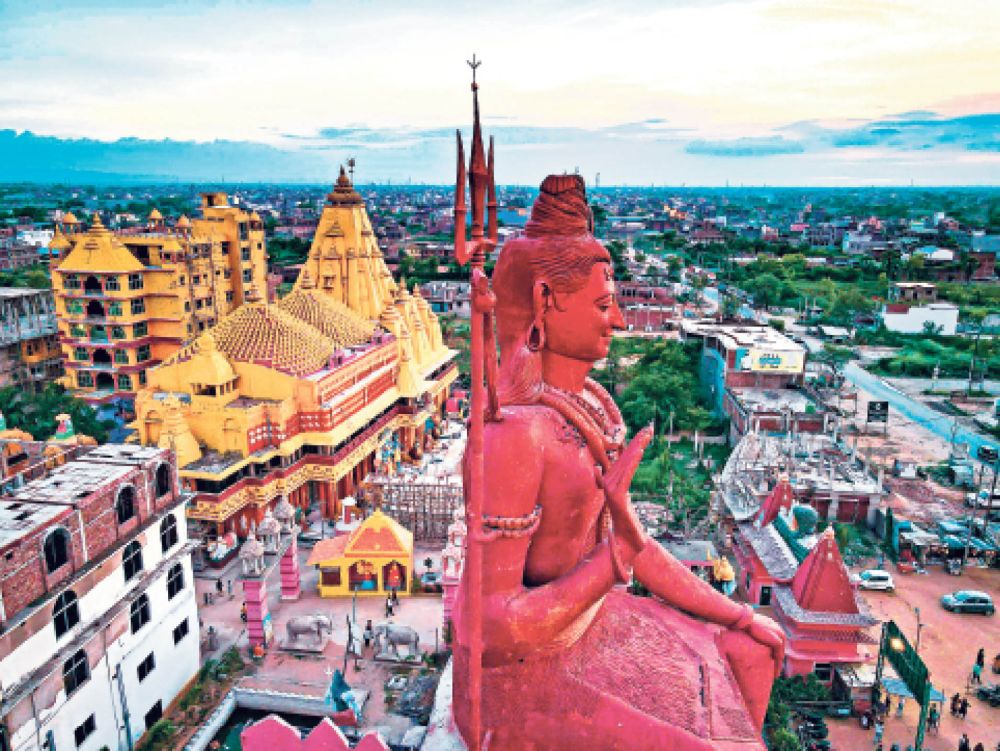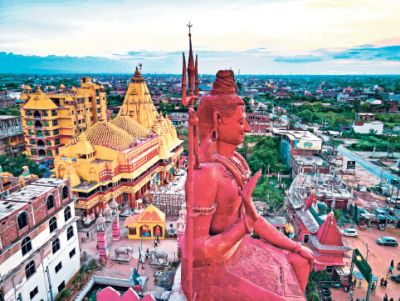

Sher Shah Suri's Tomb is a historical monument of great significance located in Sasaram. It is an architectural marvel built in the memory of Emperor Sher Shah Suri, a Pathan from Bihar who ruled over India and defeated the Mughal Empire. The tomb stands in the middle of an artificial lake and is made of red sandstone with an imposing dome. It reflects the Indo-Islamic style of architecture with intricate carvings and calligraphy. Visitors come from all around to witness the grandeur and delve into the rich history of the region. The tomb is a perfect place for history buffs and architecture enthusiasts to explore. A visit to this tomb can give you a glimpse into the past glory and architectural prowess of the empire that once ruled India. This historically rich site is peaceful and gives you a sense of walking through the pages of history.
The Rohtasgarh Fort is one of the oldest forts in India, offering breathtaking views from the top of the hill where it is located. This fort has a complex history and has been controlled by numerous dynasties and empires, including the Hindu Shahis, the Ghurids, the Mughals, and the British. Located around 50 kilometers from Sasaram, it covers a large area and is surrounded by thick forests and wildlife. The architecture features a blend of Indian and Afghan styles. Visitors should be prepared for a fair amount of hiking and climbing to explore the fort fully, as it extends over a vast area with several gates and walls. Three temples located within the complex offer additional insights into the religious practices that took place here. It's a fantastic place to explore, photograph, and learn about Indian military architecture and history.
Dhua Kund is a natural spring located in Sasaram which is known for its clean and refreshing water. The spring has a religious significance to the locals and is often visited during auspicious days for rituals and worship. The surrounding area is calm and serene, making it a perfect spot for picnics and family outings. The place is not much commercialized, which helps in keeping the environment peaceful and the water unpolluted. Visitors can enjoy the tranquility of nature here and the crystal-clear water of Dhua Kund. A dip in the water is said to be refreshing and spiritually uplifting. Moreover, being easily accessible, Dhua Kund is a must-visit for anyone looking to experience the serene side of Sasaram and to get a break from the hustle and bustle of daily life.
Dehri On Sone, situated near Sasaram, is known for its grand celebration of the Chhath Puja, a popular Hindu festival dedicated to the Sun God and his wife Usha. During this festival, the banks of the Sone River are transformed into a spiritual hub with thousands of devotees gathered to perform rituals and offer prayers. Attending the Chhath Puja provides a unique cultural experience where visitors can witness the deep-rooted traditions of Bihar, including the folk songs sung during the festival. It's an excellent opportunity for photographers and culture enthusiasts to capture the festivity and devotion. The experience of Chhath Puja is truly enchanted during sunset and sunrise when the entire riverside lights up with earthen lamps and the air is filled with the chants and prayers.
Located near Sasaram, the Gupta Period Rock-Cut Cave is a significant historical site that dates back to the 4th-6th century CE. This cave is an example of early Indian rock-cut architecture, and it is carved out of a single rock with detailed inscriptions and sculptures. The cave is believed to have been used for religious purposes, originally by Buddhists and later by Jain monks. History enthusiasts visiting this site can step back in time and explore the cultural heritage of ancient India. The cave provides a quiet and introspective atmosphere that allows visitors to contemplate the lives and practices of the monks who once inhabited it. A visit to this lesser-known marvel offers unique insights into the region's past and a chance to admire the skill and artistry of ancient craftsmen.
Although not exactly in Sasaram, the nearby town of Sonepur hosts the famed Sonepur Cattle Fair, considered one of Asia's largest cattle fairs. The fair takes place annually in the month of November and attracts visitors and vendors from all across India. Here, you can see a variety of livestock, including elephants, horses, oxen, dogs, and birds up for sale. The fair isn't just about trade; it's a cultural festival featuring traditional dances, music performances, arts, and local cuisines. The atmosphere is dynamic and vibrant, making it an excellent opportunity for visitors to immerse themselves in the local culture and interact with the people of Bihar. It's a fascinating spectacle that combines commerce, tradition, and festivity, providing a unique and memorable experience for all who attend.
Manjhar Kund is another natural attraction near Sasaram that deserves a visit. It is a series of cascading waterfalls located amidst the scenic hills, providing a delightful getaway for nature lovers and adventure seekers. The trek to Manjhar Kund involves walking through some picturesque landscapes filled with greenery and vibrant flora and fauna. During the monsoons, the waterfalls are in full flow and offer an enchanting sight. Visitors can take a dip in the pool formed by the waterfalls or simply relax by the rocks, basking in the serene environment. The trek to reach Manjhar Kund and the time spent there can be rejuvenating and offers a refreshing break from the city life. It is an adventure activity that combines hiking with the pleasure of natural beauty and is suitable for people of all ages.
In the heart of Sasaram lies the ancient gateway called Hathiya Pol, which translates to 'Elephant Gate'. This historical structure is made of sandstone and is known for its massive size and exquisite carving that give it a majestic look. It is said that this gate was part of the old fortifications protecting the city. Legend has it that the passage was wide enough for elephants to pass through, hence the name. Visitors can explore the gate and the neighboring areas, which are steeped in local lore and historical anecdotes. Walking through this gate is akin to stepping back into time, and it's a treat for anyone interested in the architectural and historical journey of Bihar. Its close proximity to other historical sights in Sasaram makes it a convenient stop for tourists looking to get the most out of their historical excursions.
No visit to Sasaram is complete without indulging in the local street food. Bihar is famous for its delicious and varied cuisine, and Sasaram is no exception. Food lovers can embark on a street food tour and taste local delicacies like litti chokha, sattu paratha, and a variety of sweets like tilkut and khaja. Each dish tells a story of the local culture and traditions. Visitors can stroll through the busy marketplaces and lanes, stopping at various vendors to sample the authentic flavors of Sasaram. A street food tour not only satisfies the palate but also provides insights into the everyday life and gastronomy of the region. This activity is perfect for food enthusiasts who are eager to explore the culinary diversity and savor the taste of traditional Bihari cuisine.
The Ramna Shiv Mandir, located on the outskirts of Sasaram, becomes a hive of activity during the annual Mela (fair) which takes place in the Hindu month of Sawan (July-August). The mela is organized to celebrate the auspicious occasion of the Maha Shivratri. Devotees from across the region gather at the temple to offer prayers to Lord Shiva and celebrate the festival. Visitors can participate in religious ceremonies, listen to mythological stories, and enjoy cultural programs showcasing music, dance, and other forms of entertainment. Stalls are set up selling religious paraphernalia, local crafts, clothes, and a multitude of street foods. It's a vibrant and colorful fair that allows tourists to experience the devotion and joy associated with one of the most important festivals in Hinduism.
